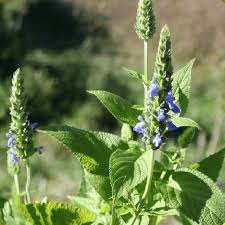Chia Seeds
The 16th-century Codex Mendoza provides evidence that it was cultivated by the Aztec in pre-Columbian times; economic historians have suggested it was as important as maize as a food crop. Ground or whole chia seeds are still used in Paraguay, Bolivia, Argentina, Mexico and Guatemala for nutritious drinks and as a food source.
Chia is an annual herb growing up to 5 feet tall. Its flowers are purple or white and are produced in numerous clusters in a spike at the end of each stem. Chia is hardy from USDA Zones 9-12.
According to the USDA, a one ounce (28 gram) serving of chia seeds contains 9 grams of fat, 5 milligrams of sodium, 11 grams of dietary fiber, 4 grams of protein, 18% of the recommended daily intake of calcium, 27% phosphorus and 30% manganese. These nutrient values are similar to other edible seeds, such as flax or sesame.
In 2009, the European Union approved chia seeds as a novel food, allowing up to 5% of a bread product's total matter.
Chia seeds may be added to other foods as a topping or put into smoothies, breakfast cereals, energy bars, granola bars, yogurt, made into a gelatin-like substance, or consumed raw.

The plant grows as an annual in all climates and as a perennial ornamental in Zones 9 through 11.
Makes a wonderful windowsill potting plant and an attractive addition to the garden.
Chia seed is the edible seed that comes from this desert plant, a member of the mint family that grows abundantly in southern Mexico. You may have seen chia sprouts growing on the novelty planters called Chia Pets, but historically, the seeds have been the most important part of the plant. In pre-Columbian times they were a main component of the Aztec and Mayan diets and were the basic survival ration of Aztec warriors. It's been written that one tablespoon was believed to sustain an individual for 24 hours. The Aztecs also used chia medicinally to stimulate saliva flow and to relieve joint pain and sore skin.
Most folks do not realize what a wonderful ( and cheap to grow ) bird food chia seeds are. They are high in Omega 3 and vitamins. Chia seeds (for birds) can improve feathering, help to keep skin supple and are a good source of Vitamin E and B, calcium and also contain boron that is good for bones.
If you grow more than you need for your feathered friends, then enjoy some for your self!.
Chia has a nutlike flavor. You can mix seeds in water and add lime or lemon juice and sugar to make a drink known in Mexico and Central America as "chia fresca." As with ground flax seeds, you can sprinkle ground or whole chia seeds on cereal, in yogurt or salads, eat them as a snack, or grind them and mix them with flour when making muffins or other baked goods.

